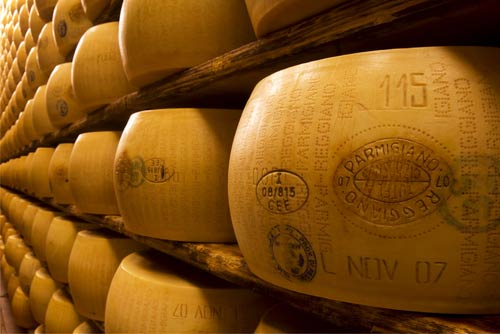Featured Ingredient ~ Parmesan Cheese

There are certain ingredients that one associates with Italian cuisine no matter where in the world you may be, such as olive oil, tomatoes, pasta, and of course Parmesan cheese. All though there are an unlimited number of brands of “Parmesan” cheese found in the marketplace these days, only a specific cheese produced in Northern Italy can legally be called Parmigiano Reggiano. This cheese, is a strictly regulated D.O.C product, that can only be produced in a specific region in Emilia-Romagna. This practice ensures that the milk used for the cheese is only taken from cows pastured on the fresh grass found on the area’s rolling hills, giving it its unique buttery flavor. True Parmigiano is made in small batches using artisanal methods following very stringent guidelines, and its flavor is often described as nutty, sweet, grassy, creamy, and even fruity.
To determine a true traditional Parmesan cheese, examine the rind for the words “Parmigiano Reggiano” which are stamped closely together all over the sides of the cheese. The plant code number as well as the date of production will also be stamped on each wheel of cheese, which may or may not be seen by the average consumer. When buying Parmigiano, choose a fresh cheese, and not one that is too hard or dried out. Ignore wedges of Parmigiano-Reggiano that has been cut, wrapped in plastic and left to sit for many days, instead ask your cheese purveyor to cut you a new piece from the wheel of Parmesan. If possible, try to avoid paying for a large piece of the rind which is all but inedible and good only for throwing into homemade soups. Never buy pre-grated Parmesan as it is always best when grated just before needed. Since true Parmigiano Reggiano is expensive, you want to ensure you store it to retain it’s optimal freshness. You can do this by either buying small pieces frequently instead of storing large pieces in your refrigerator, or if that isn’t practical, wrap the unused portion in damp paper towels and then wrap in aluminum foil. Store the wrapped wedge in the vegetable compartment in your refrigerator until needed. It is recommended that you do not freeze the cheese which will dry it out.
Parmigiano-Reggiano can be used in a myriad of ways, for every course. It is wonderful paired with such fruit as figs or melon and meat such as carpaccio and prosciutto. It is also great grated on top of pasta or soups, shaved on top of salads or pizzas, or cut into small chunks to nibble with fruit and honey for dessert. Serve Parmigiano-Reggiano with a light to medium red wine such as Chianti, Valpolicella, or Lambrusco, or if you prefer white wine, it is great paired with Proseco. When serving Parmigiano for dessert, such sweet wines as Moscato or Vin Santo complement it beautifully. If you have not had the pleasure of tasting a real Parmigiano-Reggiano, to enjoy the subtle complexity of Parmigiano-Reggiano, cut a small piece and let it melt on your tongue which allows you to enjoy it’s amazing range of delicate flavors to spread across your taste buds. Although expensive, if you can afford it even occasionally, a true wedge of Parmigiano Reggiano is well worth the splurge for your special celebrations.
Deborah Mele